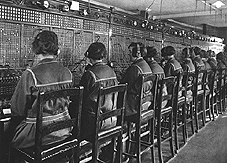The history of the telephone ...
 In
1876 Professor Alexander Graham Bell's assistant Mr Watson heard speech transmitted by a
telephone for the first time. It was Professor Bell shouting in a microphone in another
room. He had spilt acid on his trousers and was shouting for help. The trousers were
quickly forgotten, for the sensational thing was that Mr Watson had heard the shout
through a microphone, wire and receiver. This is the principle called telephony.
In
1876 Professor Alexander Graham Bell's assistant Mr Watson heard speech transmitted by a
telephone for the first time. It was Professor Bell shouting in a microphone in another
room. He had spilt acid on his trousers and was shouting for help. The trousers were
quickly forgotten, for the sensational thing was that Mr Watson had heard the shout
through a microphone, wire and receiver. This is the principle called telephony.
Others were doing similar experiments at the same time, but Bell was
the first to take out a patent on the telephone. Conversations could now be conducted
long-distance, just as written messages could already be sent by telegraph. Distinguished
magazines wrote that it might be an amusing play-thing for private individuals, but there
was no future for telephony.
Things were to turn out quite differently. The first telephone
companies were soon formed, and 1881 saw the opening of the first telephone exchange in
Denmark with 22 subscribers. This was part of the Copenhagen Telephone Company, later
KTAS, and now TeleDanmark. The telephone spread throughout the country. KTAS had 47,000
subscribers by 1910, half a million by 1960 and one million already by 1978. The
technology improved and the networks were expanded so that more calls could be handled.
The Danish Telephone Museum illustrates the technical development of the telephone with
more than 400 exhibits. Some of these are displayed in our "Virtual Museum" with
a short text relating the story behind them.

 Telephony was first introduced to
the Danish public in 1881. That was when the first Danish telephone exchange was opened.
The company drew wires across the roofs of the city, and calls were made from wall sets
with a fixed microphone and separate receiver. From Copenhagen, telephones now spread to
the rural districts as well.
Telephony was first introduced to
the Danish public in 1881. That was when the first Danish telephone exchange was opened.
The company drew wires across the roofs of the city, and calls were made from wall sets
with a fixed microphone and separate receiver. From Copenhagen, telephones now spread to
the rural districts as well.
In 1910 KTAS had 47,000 subscribers. They made 100 million calls
annually. And although two world wars hampered developments, there were 257,000
subscribers by 1945. That year they conversed 625 million times.
It took 79 years, but by 1960 there were half a million subscribers
registered with KTAS. Just 18 years later, in 1978, there were one million. And the tale
continues, because 96 percent of all Danes now have a telephone and the technology
develops.
Post
& Tele Museum - KÝbmagergade 37 - Postboks 2053 - 1012 KÝbenhavn K
Tel. 33 41 09 00 - email:museum@ptt-museum.dk
 In
1876 Professor Alexander Graham Bell's assistant Mr Watson heard speech transmitted by a
telephone for the first time. It was Professor Bell shouting in a microphone in another
room. He had spilt acid on his trousers and was shouting for help. The trousers were
quickly forgotten, for the sensational thing was that Mr Watson had heard the shout
through a microphone, wire and receiver. This is the principle called telephony.
In
1876 Professor Alexander Graham Bell's assistant Mr Watson heard speech transmitted by a
telephone for the first time. It was Professor Bell shouting in a microphone in another
room. He had spilt acid on his trousers and was shouting for help. The trousers were
quickly forgotten, for the sensational thing was that Mr Watson had heard the shout
through a microphone, wire and receiver. This is the principle called telephony. 
 Telephony was first introduced to
the Danish public in 1881. That was when the first Danish telephone exchange was opened.
The company drew wires across the roofs of the city, and calls were made from wall sets
with a fixed microphone and separate receiver. From Copenhagen, telephones now spread to
the rural districts as well.
Telephony was first introduced to
the Danish public in 1881. That was when the first Danish telephone exchange was opened.
The company drew wires across the roofs of the city, and calls were made from wall sets
with a fixed microphone and separate receiver. From Copenhagen, telephones now spread to
the rural districts as well.